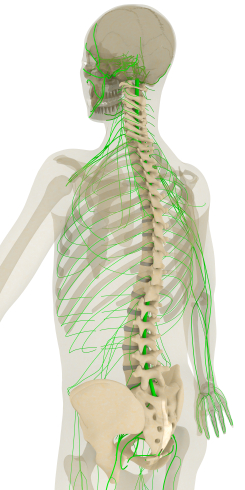Peripheral Neuropathy is a disorder of the peripheral nerves that connect the spinal cord to muscles, skin and internal organs. It usually affects the hands and feet, causing weakness, numbness, tingling and pain. Its course is variable – it can come and go, slowly progressing over many years or it can become severe and debilitating. It is estimated that over 20 million Americans suffer from this illness than is more common among older adults.
 Peripheral Neuropathy usually starts with numbness, prickling or tingling in the toes or fingers. It may spread up to the feet or hands and cause burning, freezing, throbbing and/or shooting pain that is often worse at night. The pain can be either constant or periodic, but usually the pain is felt equally on both sides of the body—in both hands or in both feet.
Peripheral Neuropathy usually starts with numbness, prickling or tingling in the toes or fingers. It may spread up to the feet or hands and cause burning, freezing, throbbing and/or shooting pain that is often worse at night. The pain can be either constant or periodic, but usually the pain is felt equally on both sides of the body—in both hands or in both feet.
The symptoms of peripheral neuropathy often include:
– Abnormalities in blood pressure or pulse
– A sensation of wearing an invisible “glove” or “sock”
– Burning sensation or freezing pain
– Sharp, jabbing or electric-like pain
– Extreme sensitivity to touch
– Difficulty sleeping because of feet and leg pain
– Loss of balance and coordination
– Muscle weakness
– Difficulty walking or moving the arms
– Unusual sweating
Symptoms such as experiencing weakness or not being able to hold something, not knowing where your feet are, and experiencing pain that feels as if it is stabbing or burning in your limbs, could be signs of peripheral neuropathy. The symptoms of peripheral neuropathy may depend on the kind of peripheral nerves that have been damaged.
Some types of peripheral neuropathy can be cured but most cannot. Therapy is directed at treating the underlying disease and at improving the symptoms with medication. To help manage peripheral neuropathy, listen to your body and respect it. Seek a healthy work-life balance and try to minimize stress.
Occupational Therapy can help recommend adaptations to help you complete daily living skills.
- A reacher can be used to help pick up objects from the floor or retrieve items from higher places.
- Pull over shirts are easier to wear but you can also leave the buttons on a button down shirt fastened and only unbutton the top one or two buttons so that you can pull it on over your head. You can also use a button hook to help.
- Elastic shoelaces can be used to convert lace-up shoes into slip-ons.
- Larger handled utensils are easier to manage. Good Grips is a brand of built up handled utensils and then can be found in many area stores.
Physical Therapy can help address pain and work on techniques to improve your balance.
